Common menu bar links
Consumer Price Index
Archived Content
Information identified as archived is provided for reference, research or recordkeeping purposes. It is not subject to the Government of Canada Web Standards and has not been altered or updated since it was archived. Please "contact us" to request a format other than those available.
Related subjects
Consumer prices rose 1.3% in the 12 months to December, following a 1.0% increase in November. December's increase was the largest since February 2009.
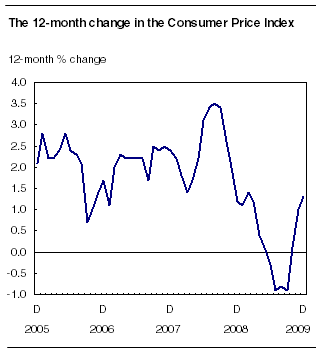
The rise in the all-items Consumer Price Index (CPI) was due primarily to gasoline prices, which exerted upward pressure on the CPI for the second consecutive month. This follows an extended period in which they were the main contributors to year-over-year declines in overall consumer prices.
In December, gasoline prices were 25.6% higher than they were in December 2008. This follows a 14.1% rise in November. December's increase was the largest since September 2008.
Overall, energy prices went up 5.9% in the 12 months to December, following a 1.3% increase in the 12 months to November.
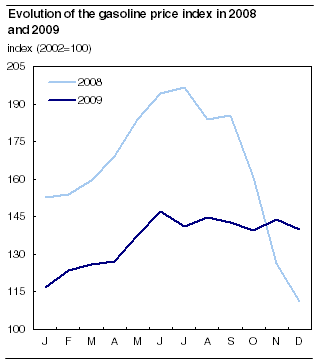
Seasonally adjusted monthly CPI decreases
On a seasonally adjusted monthly basis, the CPI fell 0.1% from November to December, after rising 0.5% from October to November. Contributors to the decline were lower prices for household operations, furnishings and equipment (-0.8%), clothing and footwear (-1.3%), and alcoholic beverages and tobacco products (-0.1%).
The seasonally adjusted monthly CPI has gone up in six of the past eight months.
12-month change: Six of the eight major components in the CPI increase
In December, six of the eight major components of the CPI recorded price increases. The exceptions were shelter and clothing and footwear.
Transportation prices, which rose 4.7% in the 12 months to December, exerted the largest upward pressure on the CPI, primarily reflecting higher gasoline prices. This was the second consecutive 12-month increase for this component. It followed 12 months of year-over-year declines between November 2008 and October 2009.
However, prices for passenger vehicles were 3.3% lower than the same period last year.
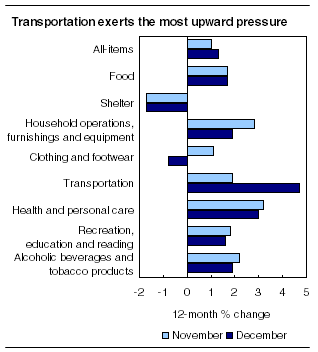
Food prices rose 1.7%, matching the increase in November. Prices for dairy products and eggs rose 1.9% while prices for non-alcoholic beverages went up 4.8%.
Other major contributors to the increase were food purchased from restaurants, sugar and confectionery, lettuce, and bakery and cereal products.
On the other hand, prices fell for fresh fruit, pre-cooked frozen food preparations, and potatoes.
The cost of household operations, furnishing and equipment rose 1.9%. Upward pressure came from communications, other household goods and services, child care and domestic services, and paper, plastic and foil supplies.
Downward pressure on the household operations, furnishing and equipment index primarily came from price declines in furniture and household textiles.
Recreation, education and reading costs advanced 1.6% in the 12 months to December. Major contributors to the increase were tuition fees, cablevision and satellite services, and the purchase and operation of recreational vehicles. In contrast, prices for computer equipment and supplies and home entertainment equipment, parts and services continued to fall.
Broad-based price advances occurred in the health and personal care component (+3.0%).
Shelter costs declined 1.7% between December 2008 and December 2009, identical to the year-over-year change in November 2009. This drop was mainly the result of a 31.2% decline in natural gas prices and a decrease in mortgage interest cost.
The mortgage interest cost index, which measures the change in the interest portion of payments on outstanding mortgage debt, fell 4.9% in December, following a 4.0% decrease in November. Also, homeowners' replacement cost declined 1.2%.
Upward pressure on the shelter component came from homeowners' maintenance and repairs costs (+3.3%) and property taxes (+4.3%).
Atlantic provinces post higher price increases than Western provinces
Prince Edward Island (+3.0%), New Brunswick (+3.0%), and Nova Scotia (+2.6%) posted the largest increases in the 12 months to December. The most significant upward pressure on prices in all provinces came from higher gasoline prices, which rose by as much as 31.9% in Prince Edward Island compared with December 2008.
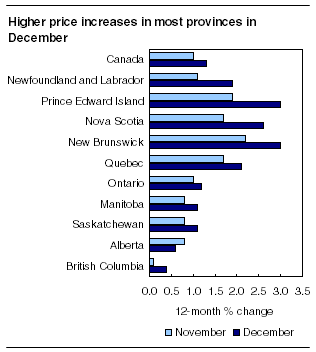
As well, prices for fuel oil and other fuels (+0.8%) were no longer exerting significant downward pressure on the CPI in December, the first 12-month increase since November 2008. These energy products are widely used in home heating in Atlantic Canada, while the rest of the country relies mostly on electricity and natural gas.
A 2.1% price increase in Quebec was driven by higher prices for gasoline and food purchased from restaurants.
In Ontario, prices rose 1.2%. This was due primarily to rises in gasoline prices (+26.8%) and passenger vehicle insurance premiums (+11.8%). However, natural gas prices fell 41.8%.
Consumer prices went up 0.6% in Alberta and 0.4% in British Columbia, with gasoline prices up 21.6% and 24.4% respectively. On the other hand, shelter costs fell 3.7% in Alberta and 3.1% in British Columbia, significantly more than the 1.7% decline posted at the national level.
12-month change in the Bank of Canada's core index
The Bank of Canada's core index advanced 1.5% over the 12 months to December, matching the increase in November.
The seasonally adjusted monthly core index went up 0.1% from November to December, following a 0.2% increase in November.
Annual change: Consumers paid less for energy in 2009
This release provides the annual average movement in components of the CPI for 2009 as a whole. Annual average indexes are calculated by averaging index levels over the 12 months of the calendar year. Annual averages should not be confused with the 12-month change in the CPI, which compares indexes for a given month to indexes for the same month a year earlier.
For 2009 as a whole, consumer prices rose by 0.3%, a significantly smaller increase than the 2.3% rise posted in 2008. The increase in 2009 was the smallest since the annual increase of 0.1% in 1994.
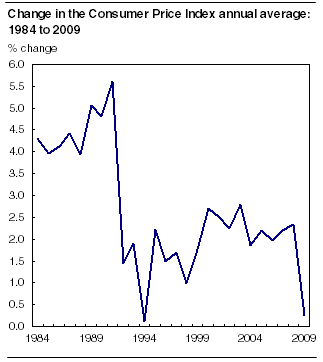
Energy prices exerted the most significant downward pressure on the CPI in 2009. Overall, prices for energy were 13.5% lower in 2009, contrasting with the 9.9% increase in 2008. Gasoline prices fell 17.5% in 2009, while prices for natural gas and fuel oil and other fuels were down 20.1% and 29.9%, respectively.
For a more detailed analysis, consult the publication The Consumer Price Index.
Available on CANSIM: tables 326-0009, 326-0012, 326-0015 and 326-0020 to 326-0022.
Definitions, data sources and methods: survey number 2301.
More information about the concepts and use of the CPI are also available online in Your Guide to the Consumer Price Index (62-557-X, free), from the Key resource module of our website under Publications.
The December 2009 issue of The Consumer Price Index, Vol. 88, no. 12 (62-001-X, free), is now available from the Key resource module of our website under Publications. A paper copy is also available ($12/$111). A more detailed analysis of the CPI is available in this publication. See How to order products.
The January Consumer Price Index will be released on February 18.
For more information, or to enquire about the concepts, methods or data quality of this release, contact the Dissemination Unit (toll-free 1-866-230-2248; 613-951-9606; fax: 613-951-2848; prices-prix@statcan.gc.ca), Consumer Prices Division.
Table 1
| Relative importance1 | December 2008 | November 2009 | December 2009 | November to December 2009 | December 2008 to December 2009 | |
|---|---|---|---|---|---|---|
| Unadjusted | ||||||
| % change | ||||||
| All-items | 100.002 | 113.3 | 115.2 | 114.8 | -0.3 | 1.3 |
| Food | 17.04 | 119.8 | 121.5 | 121.8 | 0.2 | 1.7 |
| Shelter | 26.62 | 123.4 | 121.3 | 121.3 | 0.0 | -1.7 |
| Household operations, furnishings and equipment | 11.10 | 105.5 | 108.5 | 107.5 | -0.9 | 1.9 |
| Clothing and footwear | 5.36 | 91.3 | 95.1 | 90.6 | -4.7 | -0.8 |
| Transportation | 19.88 | 110.3 | 115.4 | 115.5 | 0.1 | 4.7 |
| Health and personal care | 4.73 | 109.9 | 113.6 | 113.2 | -0.4 | 3.0 |
| Recreation, education and reading | 12.20 | 101.2 | 103.7 | 102.8 | -0.9 | 1.6 |
| Alcoholic beverages and tobacco products | 3.07 | 128.7 | 131.3 | 131.2 | -0.1 | 1.9 |
| All-items (1992=100) | 134.9 | 137.2 | 136.6 | -0.4 | 1.3 | |
| Special aggregates | ||||||
| Goods | 48.78 | 106.5 | 108.6 | 107.6 | -0.9 | 1.0 |
| Services | 51.22 | 120.1 | 121.8 | 121.8 | 0.0 | 1.4 |
| All-items excluding food and energy | 73.57 | 111.0 | 112.2 | 111.7 | -0.4 | 0.6 |
| Energy | 9.38 | 123.0 | 132.4 | 130.3 | -1.6 | 5.9 |
| Core CPI3 | 82.71 | 112.6 | 114.7 | 114.3 | -0.3 | 1.5 |
Table 2
| Relative importance1 | December 2008 | November 2009 | December 2009 | November to December 2009 | December 2008 to December 2009 | |
|---|---|---|---|---|---|---|
| Unadjusted | ||||||
| % change | ||||||
| Canada | 100.002 | 113.3 | 115.2 | 114.8 | -0.3 | 1.3 |
| Newfoundland and Labrador | 1.27 | 113.1 | 115.6 | 115.2 | -0.3 | 1.9 |
| Prince Edward Island | 0.35 | 114.7 | 119.1 | 118.1 | -0.8 | 3.0 |
| Nova Scotia | 2.56 | 113.4 | 117.0 | 116.3 | -0.6 | 2.6 |
| New Brunswick | 1.97 | 111.2 | 115.1 | 114.5 | -0.5 | 3.0 |
| Québec | 21.05 | 111.7 | 114.3 | 114.0 | -0.3 | 2.1 |
| Ontario | 41.22 | 112.8 | 114.6 | 114.1 | -0.4 | 1.2 |
| Manitoba | 3.06 | 113.0 | 114.7 | 114.2 | -0.4 | 1.1 |
| Saskatchewan | 2.64 | 115.8 | 117.6 | 117.1 | -0.4 | 1.1 |
| Alberta | 11.43 | 121.2 | 122.6 | 121.9 | -0.6 | 0.6 |
| British Columbia | 14.29 | 111.4 | 112.4 | 111.9 | -0.4 | 0.4 |
| Whitehorse | 0.06 | 113.9 | 113.9 | 113.4 | -0.4 | -0.4 |
| Yellowknife | 0.08 | 115.4 | 116.7 | 116.8 | 0.1 | 1.2 |
| Iqaluit (Dec. 2002=100) | 0.02 | 112.4 | 111.2 | 111.3 | 0.1 | -1.0 |
Table 3
| Relative importance1 | October 2009 | November 2009 | December 2009 | October to November 2009 | November to December 2009 | |
|---|---|---|---|---|---|---|
| Seasonally adjusted | ||||||
| % change | ||||||
| All-items | 100.002 | 114.9 | 115.5 | 115.4 | 0.5 | -0.1 |
| Food | 17.04 | 121.4 | 121.8 | 122.0 | 0.3 | 0.2 |
| Shelter | 26.62 | 121.2 | 121.3 | 121.3 | 0.1 | 0.0 |
| Household operations, furnishings and equipment | 11.10 | 108.0 | 108.6 | 107.7 | 0.6 | -0.8 |
| Clothing and footwear | 5.36 | 93.4 | 93.9 | 92.7 | 0.5 | -1.3 |
| Transportation | 19.88 | 113.4 | 115.4 | 115.5 | 1.8 | 0.1 |
| Health and personal care | 4.73 | 113.0 | 113.3 | 113.3 | 0.3 | 0.0 |
| Recreation, education and reading | 12.20 | 103.7 | 103.8 | 103.8 | 0.1 | 0.0 |
| Alcoholic beverages and tobacco products | 3.07 | 131.4 | 131.3 | 131.2 | -0.1 | -0.1 |
| Special aggregates | ||||||
| All-items excluding food | 82.96 | 113.5 | 114.0 | 113.3 | 0.4 | -0.6 |
| All-items excluding food and energy | 73.57 | 111.8 | 111.8 | 111.8 | 0.0 | 0.0 |
| All-items excluding eight of the most volatile components | 82.71 | 112.8 | 113.0 | 113.1 | 0.2 | 0.1 |
| Core CPI3 | 82.71 | 114.2 | 114.4 | 114.5 | 0.2 | 0.1 |

